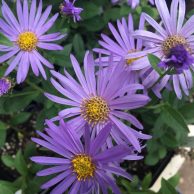
At this time of year, when the weather is hot and mostly dry, it can be easier to establish transplants that already have a larger, deeper root system. Another very important factor in successful transplanting in this heat and drought is the quality of the potting soil the plant was grown in. Harlequin’s Gardens doesn’t use a commercial, lightweight, soil-less mix, designed for using chemical fertilizers and for minimizing shipping costs.
Unlike most growers, we formulate our own potting soils (different recipes for different types of plants and different pot sizes). We use locally sourced, nutritive composts and we include mycorrhizae in our mixes. We combine premium natural and organic ingredients to make living soils that nourish and strengthen the plants and their defenses so that when planted in the ground, they have already made relationships with beneficial microbes and know how to feed themselves through these symbiotic partnerships. Planted correctly and given regular watering until established, they should hardly miss a beat.
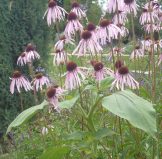
Echinacea pallida
Every spring we transplant some of our newly propagated or newly received perennials into larger pots so that they will be ready to be successfully planted into your gardens later in the summer. We especially feature some of the varieties that bloom in late summer and fall. Many of these are essential season-extenders for pollinators and beneficial insects, offering plenty of nectar and pollen.
Here are a few of the beauties we have ready now in 1-gallon pots:
Aster x frikartii ‘Monch’ (pictured above, left)
Chrysanthemum ‘Clara Curtis’
Dwarf False Indigo (Baptisia minor)
Pale Purple Coneflower (Echinacea pallida}
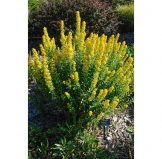
Solidago ‘Wichita Mountain’. Photo Credit: Water Wise Plants / Colorado Springs Utilities
Rosemary ‘Creeping’ (Rosmarinus o. prostratus)
Rosemary, hardy ‘Madeline Hill’
Rudbeckia maxima
Salvia ‘Shangri La’ Plant Select®
Sedum telephium ‘Autumn Fire’
Sedum telephium ‘Indian Chief’
Solidago ‘Wichita Mountains’
A little more information on a few of these perennials:
Blue False Indigo (Baptisia minor)
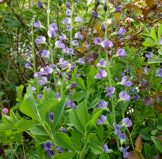 This lesser-known herbaceous perennial native to the Central U.S. is a dwarf version of the more widely known False Indigo, but is smaller in overall stature, standing only 1.5 to 2’ tall, and in leaf, flower, and pod size. Stems are slender but stiff and sturdy, and leaves is often thicker than those of its big sister. Blooming in May and June, the showy purple-blue pea flowers are held in upright racemes and attract bumblebees and butterflies. Though slow to establish, Baptisia is one of those plants that will probably outlive you, like Peony and Gas Plant, slowly increasing in size and tenacity. Once established, it tolerates dry soils of many types, from clay to rocky, resists rabbits, and is not bothered by insect pests or diseases. Fall color is gold, and when dormant the plant disappears for the winter. New growth is dark purple and hard to see against the soil, so be sure to mark the spot so you don’t inadvertently damage or remove it while dormant or newly emerging.
This lesser-known herbaceous perennial native to the Central U.S. is a dwarf version of the more widely known False Indigo, but is smaller in overall stature, standing only 1.5 to 2’ tall, and in leaf, flower, and pod size. Stems are slender but stiff and sturdy, and leaves is often thicker than those of its big sister. Blooming in May and June, the showy purple-blue pea flowers are held in upright racemes and attract bumblebees and butterflies. Though slow to establish, Baptisia is one of those plants that will probably outlive you, like Peony and Gas Plant, slowly increasing in size and tenacity. Once established, it tolerates dry soils of many types, from clay to rocky, resists rabbits, and is not bothered by insect pests or diseases. Fall color is gold, and when dormant the plant disappears for the winter. New growth is dark purple and hard to see against the soil, so be sure to mark the spot so you don’t inadvertently damage or remove it while dormant or newly emerging.
Pale Purple Coneflower (Echinacea pallida)
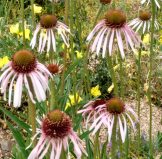 Pale Purple Coneflower grows up to 3′ feet tall and has distinctive and graceful pale purple to pink flowers with long, narrow, drooping petals around a russet central cone. It blooms in early summer when only a few of the sun loving plants are in bloom and provides nectar for hummingbirds and butterflies, and the leaves provide food for the Ottoe-skipper butterfly larva. Plant Pale Purple Coneflower in well-drained soil in full to partial sunlight. Most native Coneflowers dislike soil that is kept excessively moist or has poor drainage and will start to rot in these situations. Once the taproot is established it is extremely drought-tolerant and needs little care, but then also may be difficult to move. In the past all the Purple Coneflowers were used as medicinal plants by the Native Americans, and the roots are still used to make herbal medicines and tonics.
Pale Purple Coneflower grows up to 3′ feet tall and has distinctive and graceful pale purple to pink flowers with long, narrow, drooping petals around a russet central cone. It blooms in early summer when only a few of the sun loving plants are in bloom and provides nectar for hummingbirds and butterflies, and the leaves provide food for the Ottoe-skipper butterfly larva. Plant Pale Purple Coneflower in well-drained soil in full to partial sunlight. Most native Coneflowers dislike soil that is kept excessively moist or has poor drainage and will start to rot in these situations. Once the taproot is established it is extremely drought-tolerant and needs little care, but then also may be difficult to move. In the past all the Purple Coneflowers were used as medicinal plants by the Native Americans, and the roots are still used to make herbal medicines and tonics.
Great Coneflower (Rudbeckia maxima)
Great Coneflower features a basal clump of large, glaucous, paddle-shaped, bluish-green leaves from which rise in summer sturdy, sparsely leaved flower stalks to 7’. Each 3” coneflower has slightly drooped yellow rays around a tall, pointed dark brown central cone ranging from 2-6” high. Flowers bloom in summer. Native to open wooded areas, moist prairies, pastures and along roads and railroad tracks in Arkansas, Oklahoma, Louisiana, and Texas, this dramatic, hardy (Zone 4) perennial coneflower is easily grown in average, moist, well-drained soils in full sun or light shade. It tolerates heat, some drought, and a somewhat wide range of soils, but performs best and reaches greater heights – 6 to 8’ – in moist, organically rich soils. In drier conditions, expect 3 to 5’ flowering stalks. It has no serious insect or disease problems. Flower stalks may be left in place after bloom so goldfinches can enjoy the seed. The flowers are wonderful in fresh or dry arrangements.
Shangri-la Sage (Salvia moorcroftiana x indica) Plant Select® 2017
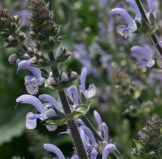
Photo Credit: Plant Select® 2017 – Pat-Hayward
This hardy perennial sage (Zones 5-9, to 6,200’) combines the best features of both its parents, being long-blooming, adaptable to sun or partial shade in most soil types with moderate to low water. Broad, sturdy leaves are an attractive blue grey shade. 2’ to 3’ flower stems arch over the foliage and display large lavender-blue flowers from bottom to top. Flowering can continue for months, beginning in spring, if the spent flower-stalks are promptly removed. Like most Sages, Shangri-la reliably attracts and supports bees, butterflies, and hummingbirds, and is not bothered by deer. Cutting stems down to the ground when blossoms fade to allow basal leaves to flourish again. Discovered as a chance seedling at Suncrest Nurseries, CA.
Wichita Mountain Goldenrod (Solidago sp.)

Solidago ‘Wichita Mountain’. Photo Credit: Water Wise Plants / Colorado Springs Utilities
Wichita Mountain Goldenrod is an unidentified species originally collected from Oklahoma. Throughout the growing season it is not that noticeable, but in early fall, its many 2-3’ upright stalks, begin to burst into bottle brush-like spikes of vibrant yellow flowers that are very attractive to bees and butterflies and support dozens of beneficial insect species. This beautiful fall bloomer adds spectacular color just ahead of the first fall frost and makes a brilliant partner to fall-blooming asters and Blue Sage (Salvia azurea grandiflora, Salvia pitcheri). Thrives in full sun in most soils with moderate to low water.
